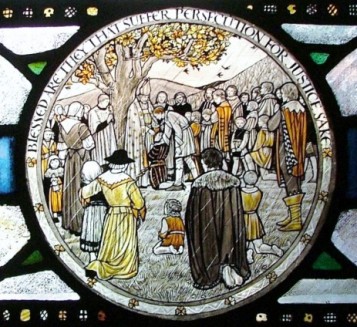
Tyburn

Tyburn field, near the present Marble Arch, was a place of public execution from 1196 to 1783. Amongst the many thousands who died there were 105 people who have been officially recognised as martyrs for the Catholic faith. English law made it an act of treason to refuse to assent to the royal supremacy over the Church claimed by Henry VIII, or to be (or to harbour) a Catholic priest. The standard penalty for all those convicted of treason at the time was execution by being hanged, drawn and quartered. The first martyrs at Tyburn were Saint John Houghton and his companions, executed on May 4, 1535. The last martyr executed at Tyburn was Saint Oliver Plunkett on July 1, 1681. Religious persecution was not uniquely practised against Catholics, of course: at other times Protestant believers faced similar fates.
In 1571, under Queen Elizabeth I, a novel form of gallows was erected at Tyburn, the “Tyburn Tree”. This “Tree” was formed from a horizontal wooden triangle supported by three legs. It was introduced better to permit the execution of several people at once.
The Catholic martyrs brought a new spirit into the barbarities and butchery of Tyburn: a spirit of spiritual joy, spontaneous humour and, in imitation of Christ, a wholehearted forgiveness of those who had brought them to their place of execution.
This spirit flowed over into the crowds around the Tyburn Gallows. When Blessed Thomas Maxfield was dragged to Tyburn in 1616, the Gallows had been adorned with garlands of fragrant flowers while the ground around it was strewn with sweet-smelling herbs and branches of laurel and bay.
Blessed Philip Powel announced from the Tyburn Tree: “This is the happiest day and the greatest joy that ever befell me, for I am brought hither for no other cause or reason than that I am a Roman Catholic priest and a monk of the Order of Saint Benedict” (1646).
Saint Edmund Campion, Jesuit priest, prayed on the scaffold for those responsible for his death: “I recommend your case and mine to Almighty God, the Searcher of hearts, to the end that we may at last be friends in heaven, when all injuries shall be forgotten” (1581).
Edward Morgan, priest, was reproved by a minister on the scaffold for being so cheerful. The martyr replied: “Why should anyone be offended at my going to heaven cheerfully? For God loves a cheerful giver” (1642).
Thus the holy martyrs transformed Tyburn’s Deadly Nevergreen Tree into the Tree of Life and the Gate of Heaven, which it remains to this very day.
In the early 19th century all the place names associated with Tyburn field were changed to Oxford Street, Park Lane etc: the little stream Ty was built over and Tyburn, with its unsavoury reputation, was forgotten except by a small number of Catholics who kept alive the memory of the martyrs and hoped that one day a fitting shrine would be erected to commemorate their sacrifices.
In 1901 the law on associations was passed in France ordering the dissolution of every religious community not authorised by the government. One such order was the Benedictine Adorers of the Sacred Heart of Jesus of Montmartre, and its members left France to make a new home in England. In 1903 they made that home in Tyburn Convent, Hyde Park Place, where they have remained for over 100 years.
The ancient gallows, where so many saints and sinners died is now commemorated in a modern replica of the “Tree” which stands in the Shrine of the Sacred Heart and Tyburn Martyrs. There, night and day, before Christ in the Blessed Sacrament placed in the Monstrance, the Tyburn Nuns pray in adoration, interceding for the Holy Father, the Church and for all the needs of the whole human family and especially for the people of England and Wales: ever mindful of the Catholic Martyrs who suffered and died on the scaffold of Tyburn Tree.
